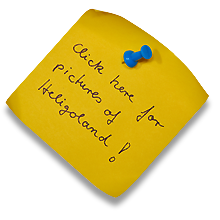- Location and arrival
- The main island
- The Düne
- Heligoland in winter
- The equipment
- Conclusion
- Download map of Heligoland
The high sea island of Heligoland belongs to the federal state of Schleswig-Holstein and is located about 70 km away from the mainland. The main island
has a size of about 1.0 km² and consists of a red sandstone block whose cliff coast rises over 60 m out of the sea. For some time now, the island has been a
destination for many nature photographers throughout the year.
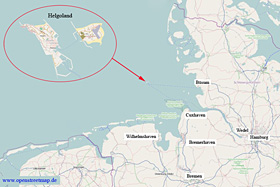
To better orient yourself, I have marked the location of the island on the overview map (for more
details, please click on the map on the left). Helgoland can be reached by plane or by ship. By plane, you can choose between Bremerhaven,
Büsum, or Hamburg as the departure airport and land on the offshore island, Düne. By ship, you have the choice between Bremerhaven,
Büsum, Cuxhaven, Emden, Wilhelmshaven, or Hamburg as the departure port. The schedules are geared towards day-trippers from the mainland,
with departure times from the mainland in the morning and return times in the evening. If you have to travel a longer distance to the port,
you may need to plan for an overnight stay on the mainland before and after the ferry.
I prefer the fast crossing by catamaran, which departs from Hamburg, Wedel or Cuxhaven. From Cuxhaven, you can reach the port of Helgoland
directly in 90 minutes and land without disembarking. However, the catamaran does not operate in the winter months, and then you can only
reach the island with the sea bathers' ships (journey time about 2.5 hours). In the winter months, it may be that the accessibility of
Helgoland by ship is reduced to the sea bathers' ship from Cuxhaven. It should also be borne in mind that the offshore island is no longer
served by scheduled services from wind force 8.
There are numerous accommodation options on Helgoland, both on the upper and lower parts of the island. Visitors can choose from hotels,
guesthouses, vacation rentals, apartments, or even a youth hostel. On the neighboring beach island of Düne, camping is possible from May to
September, as well as renting bungalows. Those planning to primarily photograph gannets and guillemots should look for accommodations on the
upper part of the island, to be as close as possible to the bird cliffs with potentially heavy photography equipment. However, those wishing
to primarily photograph seals, sea lions, and waders on Düne are better off staying in the lower part of Helgoland or even on Düne itself.
(back to top)
Helgoland is located on different levels of height and is divided into upper, middle, and lower parts. To reach the upper part, one can use
a paid elevator or alternatively climb up 184 stairs.
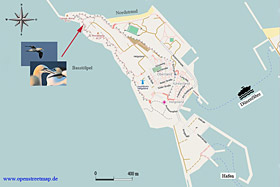
On the map next to this text, I marked the location from which you can best photograph the Northern Gannets and the
Common Murres. It is the "Lummenfelsen" (murre cliff), which is also marked by a small signpost. However, it should not be difficult for first-time
visitors to find the spot, as many other nature photographers also gather there. From March until the end of summer, the conditions at the bird
cliff are excellent, and sometimes more than 10,000 birds can be observed there. The Northern Gannets build their nests near the edge of the cliff
path, making it possible to photograph the birds up close. The Common Murres are located a little further away and usually sit a bit lower on the
protrusions of the steep wall. The "Lummensprung," where the flightless chicks jump off the cliff, takes place from mid-June to mid-July in the
evening hours and is therefore very difficult to photograph.
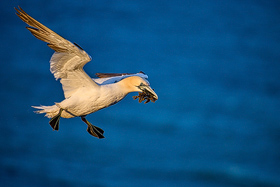
The best times for photographing the Northern Gannets, as often in nature photography, are the morning and evening hours.
Most nature photographers gather in the evening hours at the Lummenfelsen, but the morning hours are also excellent for photography, so I was somewhat
surprised when I arrived there alone in the morning on my first visit to Heligoland. Depending on the wind direction, the gannets fly in from the
northwest or southwest. With the right updraft, they remain almost stationary in the air for some time, providing a great opportunity to photograph them.
However, it is also common for the birds to fly low, and then you only have the opportunity to shoot from above. With digital photography, care should be
taken not to overexpose the white plumage, as the lost detail cannot be recovered. Unfortunately, I cannot make a general recommendation for exposure, as
different camera models react very differently, so the camera's histogram should always be kept in mind.
(back to top)

The island of Düne is located about 1 km away from Helgoland and can be reached by the
"Dünenfähre" or by plane from the mainland. The
small ferry takes about 5 minutes for the crossing. The fare for the ferry to Düne is 6 Euros (as of December 2020) and is valid for the round trip. The
ferry operates at different times depending on the season. In the summer months, the ferry runs every half hour, and in the winter, it runs every hour. I recommend
inquiring at the landing stage for the exact times, as last-minute changes are always possible, and there are often early-morning ferries that are not listed on the
schedule. In bad weather conditions, the ferry may depart from the Nordosthafen
(see also map).
The Dune has a length of approximately 1000 meters and a width of approximately 700 meters. There are two wide sandy beaches in the north and south. The surf is a bit
larger on the northern beach, and one usually finds the grey seals there, while at the southern beach, mostly harbor seals (but not in winter) can be found. On the east
side of the island, there is also a pebble beach where seals can often be seen.
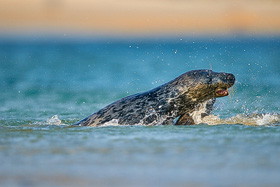
During the summer months, I recommend taking the first ferry to take advantage of the soft morning light. Additionally, seals are most active in the
morning, and you often have the chance to witness a water battle. The seals are accustomed to humans; however, it is recommended to keep a distance of 30 meters whenever possible.
Nevertheless, this may not always be easy as the seals may come close if you're already lying on the beach. In any case, the seals should always be given an escape route, so please
do not hinder them from going into or coming out of the sea.
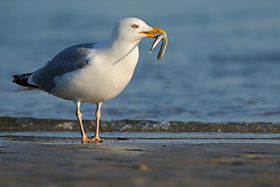
In addition to the seals, you can also observe and photograph a wide variety of birds on the Dune. Both on the North Beach and on the South Beach, you can
discover waders and other birds at any time. The best approach is to simply lie down and wait for the birds to approach on their own. In the middle of the island, there are also
two water holes
(see map),
which are particularly visited by migrating birds. During bad weather, there are greater chances of finding birds at the water holes, as many migratory birds fly over the island
without landing during good weather.
(back to top)
Even in winter, the island offers plenty of opportunities for nature photographers. First and foremost are the births of grey seals, which take place on the dune from November
to December. Winters on Helgoland are relatively mild as the weather is influenced by the nearby Gulf Stream. In some winters, however, it is possible to witness snowfall, and the
red sandstone looks beautiful covered in white snowflakes. However, the birdlife in winter is not very pronounced as most birds have migrated to the south. During my first winter
stay on Helgoland, I mainly spotted some gulls, cormorants, a few oystercatchers, sanderlings, and some turnstones. I discovered the turnstones on the main island's north beach.
A visit to the north beach of the main island is worth it at any time of the year, as many seabirds can be regularly observed there as well.
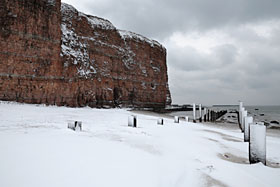
Besides the scenic impressions, seal pup watching on the Düne is, of course, one of the highlights in winter. The conditions in winter are, of course,
different from the warmer months on Helgoland. The positive aspect is the light in winter; one can practically photograph all the time and never has really "harsh" light even in
sunshine. However, the negative point is, of course, the cold that accompanies one while photographing. Since I generally recommend taking animal photos at eye level, it is
inevitable to lie in the sand. If the right clothing is chosen, however, this should not be a problem. During the birthing months and until the seal pups become independent
and go foraging, the Düne presents a completely different picture compared to other months. While in spring and summer, seals lie together in smaller to larger groups, in the
winter months, the seals lie scattered all over the beach, and one can mainly find the grey seal mothers together with their pups on the beach. Visitors should be careful not
to disturb the seals and prevent them from reaching their pups.
Two more tips: In winter, enough batteries should be taken along, as discharge progresses much faster in the cold. When taking pictures in the snow, almost always a manual
exposure correction must be made, as the camera's automatic setting is based on a middle gray value. This means a correction of + 1/3 to + 2, depending on how much white
is present in the image.
(back to top)
The appropriate equipment for Helgoland can look very different and from my point of view, one cannot really do anything wrong here. The fact is that many animals on Helgoland
are quite accustomed to humans, so the escape distances are relatively short. Nevertheless, larger telephoto lenses make a lot of sense, as one should not disturb the animals as
much as possible and for bird photography, a lot of focal length is usually required anyway. In my following statement on focal length, I refer to APS-C, as this is still the
format among DSLRs that is most widely used..
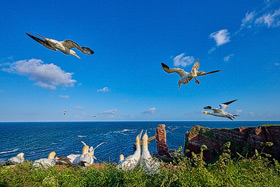
For aerial shots of the Northern Gannets at Lummenfelsen, smaller telephoto lenses are sufficient. 200 to 300mm focal length is often enough since the Northern
Gannets build their nests quite close to the cliff edge path and the distances during approach are very short. Some of the gannets are so close,
that you can also photograph them very well with a wide-angle lens. However, if the goal is to capture portraits of the birds, 500 to 600mm should
be available. The most of my shots of the Northern Gannets were taken with a 300mm, 400mm or a 600mm telephoto lens.

I recommend larger focal lengths (at least 400mm, preferably more) for bird photography on the Dune. Those who can patiently wait for the birds to come
closer will surely succeed. For seals, 300 to 400mm focal length should be planned. However, more focal length for seals, especially for detailed shots, also does not hurt ;-)
For landscape photography, one should not do without smaller focal lengths and wide-angle lenses. Due to weight reasons, I prefer zoom lenses for smaller focal lengths. Furthermore,
a tripod should not be missing in the equipment. A macro lens can also be useful, although I must admit that I always had it with me on my visits but have not used it during any of
my previous stays on Heligoland due to the many other possible motives.
I would recommend taking appropriate protection for your equipment as the conditions, especially on the dune, can be rough at times. For the lenses, where possible, I would suggest
taking a protective filter and using a protective cover for the large telephoto lenses (see photo). These protective measures should be followed when working close to the ground,
as otherwise the sand that is kicked up can easily cause damage.
(back to top)
My personal conclusion can be drawn very quickly, because the island of Heligoland is extremely worthwhile for nature lovers and it is not without reason that the island is a
magnet for numerous nature photographers every year. A stay in Heligoland is worthwhile at any time of the year, as in spring the birdlife is most abundant, in summer the birth
of the Northern Gannets or the "Lummensprung" takes place, in autumn the bird migration over Heligoland takes place and finally in winter the birth of the Grey Seals can be
seen and photographed.
(back to top)
You can download maps of the island of Heligoland and the Dune here. To view and print them, you will need an Acrobat Reader.
 Maps of Heligoland
Maps of Heligoland
written: Januar 2010, (author: Olaf Juergens)
updated: July 2024
 print version
print version










